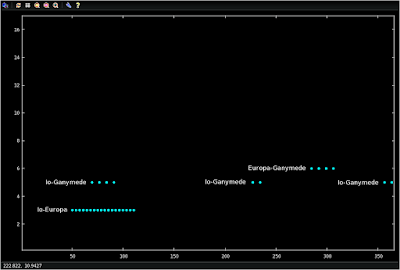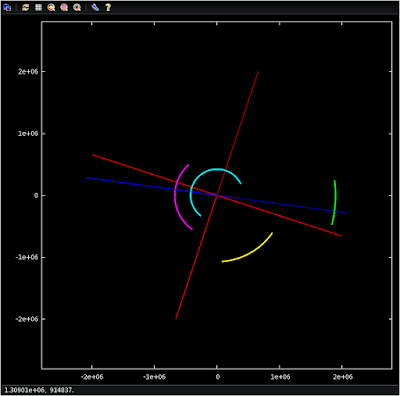"Dave!", I thought, "why did you mention these events if for no other reason than filler so you could get up to your famous 101 events?" You were actually very very lucky to have just the right number of double shadow events to fill what would otherwise be a big gap in your list.
Mutual events involving two or more moons plus Jupiter itself is pretty exciting, but aren't there any other things -- perhaps more interesting -- going on there? What about actual moon transits? Too many or too few to fit into your pre-determined number of top events for 2016?
I, for one, don't think that the moon transits should be left out, especially if you're already looking for moon shadow transits anyhow. But listing shadows and transits would have made the list way too unbalanced, so maybe this is why Dave chose just the shadow events -- because they fit.
So I decided to take a look and see what else is happening at Jupiter this year from Earth's POV. Plus, like any good scientist, I wanted to check Dave's work. I'm happy to announce that, for the most part, our results agrees.
So I found Galilean moon event predictions at the IMCCE and wrote a program to parse the data and tell me when each moon is transiting and when it's shadow is transiting.
I then produced these plots. The first shows the shadow events and the 2nd shows the transit events.
 |
| Shadow Events |
 |
| Transit Events |
The y-axis is an arbitrary value that allows me to separate events. The x-axis is the day number for this year (2016). I've labeled the events.
According to this data, there are 25 'double shadow' events and 30 'double transit' events. The two events that Dave has on his list that I don't have on mine are:
12 April double shadow Io - Europa
08 November double shadow Ganymede - Europa
Not quite sure where Dave got his data, but this is clearly a case of "your results are only as good as your data".
Here are the events I found (EV=event, MM=month, DD=day, HH=hour, MM=minute):
Shadows (under the EV column: I = Io, E = Europa, G = Ganymede, C = Callisto):
EV MM DD HH MM MM DD HH MM Comment
----------------------------------------------
1. IE 2 22 20 42 - 2 22 20 46
2. IE 2 26 9 38 - 2 26 10 4
3. IE 2 29 22 35 - 2 29 23 22
4. IE 3 4 11 32 - 3 4 12 40
5. IE 3 8 0 29 - 3 8 1 59
6. IG 3 9 18 57 - 3 9 19 11
7. IE 3 11 13 26 - 3 11 15 17
8. IE 3 15 2 23 - 3 15 4 35
9. IG 3 16 20 51 - 3 16 23 6 Io Passes Gan
10. IE 3 18 15 19 - 3 18 17 35 Io Passes Eur
11. IE 3 22 4 24 - 3 22 6 32
12. IG 3 23 23 48 - 3 24 1 0
13. IE 3 25 17 42 - 3 25 19 29
14. IE 3 29 7 1 - 3 29 8 26
15. IE 4 1 20 19 - 4 1 21 23
16. IC 4 3 15 12 - 4 3 15 51
17. IE 4 5 9 38 - 4 5 10 20
18. IE 4 8 22 56 - 4 8 23 17
19. IC 5 7 4 40 - 5 7 5 43
20. IG 8 7 5 32 - 8 7 6 34
21. IG 8 14 7 33 - 8 14 9 41
22. IG 8 21 11 31 - 8 21 11 36
23. EG 10 17 20 59 - 10 17 22 14
24. EG 10 24 23 33 - 10 25 2 8 Eur Passes Gan
25. EG 11 1 3 20 - 11 1 4 41
Transits:
EV MM DD HH MM MM DD HH MM Comment
----------------------------------------------
1. IE 2 19 8 11 - 2 19 8 18
2. IE 2 22 21 3 - 2 22 21 27
3. IE 2 26 9 54 - 2 26 10 34
4. IE 2 29 22 46 - 2 29 23 43
5. IE 3 4 11 38 - 3 4 12 50
6. IE 3 8 0 30 - 3 8 1 58
7. IG 3 9 18 55 - 3 9 18 59
8. IE 3 11 13 21 - 3 11 15 6
9. IE 3 15 2 13 - 3 15 4 14
10. IG 3 16 20 39 - 3 16 22 15
11. IE 3 18 15 5 - 3 18 17 20 Io Passes Eur
12. IE 3 22 3 57 - 3 22 6 12 Io Passes Eur
13. IG 3 23 22 23 - 3 24 0 38 Io Passes Gan
14. IE 3 25 16 52 - 3 25 19 4
15. IE 3 29 6 1 - 3 29 7 56
16. IG 3 31 1 40 - 3 31 2 22
17. IE 4 1 19 10 - 4 1 20 49
18. IE 4 5 8 19 - 4 5 9 41
19. IE 4 8 21 29 - 4 8 22 34
20. IE 4 12 10 40 - 4 12 11 28
21. IE 4 15 23 50 - 4 16 0 21
22. IE 4 19 13 2 - 4 19 13 15
23. IG 8 14 6 46 - 8 14 7 56
24. IG 8 21 9 5 - 8 21 11 2
25. EG 10 10 18 53 - 10 10 19 17
26. EG 10 17 21 41 - 10 17 23 42
27. EG 10 25 1 13 - 10 25 3 3
28. EG 11 1 5 40 - 11 1 5 49
29. IG 12 21 13 19 - 12 21 14 18
30. IG 12 28 16 1 - 12 28 17 26
What I think is very very cool about these events is that in some of them, one moon passes the other one while both are in transit!!!!!
In 2016, there are no triple or quadruple shadows or transits, unlike in 2015. I looked ahead to 2017 and see pretty much the same as 2016.























































